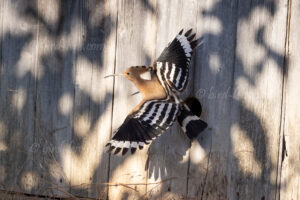 Almost everyone knows the Hoopoe (Upupa epops) with its unusual headdress and friendly face. But there are only a few places in Germany where you can observe it quite easily. The Kaiserstuhl in the south-western corner of Germany is one of these special places, with one of the highest population densities in Germany.
Almost everyone knows the Hoopoe (Upupa epops) with its unusual headdress and friendly face. But there are only a few places in Germany where you can observe it quite easily. The Kaiserstuhl in the south-western corner of Germany is one of these special places, with one of the highest population densities in Germany.
But that was not always so. In 1990 the Hoopoe was on the German list of species threatened with extinction, and there were only five breeding pairs left in the Kaiserstuhl. Due to the intensification of agriculture and large-scale land consolidation, this cave breeder, which prefers to use abandoned woodpecker holes, found hardly any breeding places. Because of the use of insecticides, it found little or only poisoned food. It is thanks to the efforts of many nature conservationists that a trend reversal was achieved and the population was able to slowly recover. Under their direction, nesting boxes were attached to vine houses, and where these were missing, three-walled mini vine huts with nest-boxes were set up. In talks with the winegrowers, it was achieved that less spraying is done and, above all, that the passages between the rows of vines, which are important for the Hoopoes foraging, are no longer treated with herbicides. Here the Hoopoe searches with its long, slightly curved beak for its favorite food, the underground-living mole cricket (Gryllotalpa gryllotalpa). With around 100 breeding pairs in the meantime, the occurrence of the Hoopoe is assured for the moment. A quarter of the German population lives here, in the neighboring Tuniberg and in the Upper Rhine Graben up to Rhineland-Palatinate.
When the Hoopoe returns from its wintering grounds from the beginning of April, the chances of a sightings in the Kaiserstuhl are best. The Kaiserstuhl is one of the warmest regions in Germany and receives relatively little rainfall. The Hoopoe returns from its winter quarters around April 5th. Because it prefers to dig in the ground between the vines for food, it is best spotted in April, when the vines have not yet formed leaves. Another highlight are the European Bee-eaters (Merops apiaster). These are only staying in the countryside for a very short time. They only come back from Africa at the beginning of May as one of the last migratory birds. After the young have fledged, most of them move on to the neighboring Rheinauen in July, where they are difficult to track down. The Kaiserstuhl is very well developed thanks to a dense network of paths. All paths are perfectly signposted, and there are also many trails with information boards.
The guided tours offered by the Kaiserstuhl Nature Center under competent guidance are highly recommended as an introduction. Instead of stubbornly following specific hiking suggestions, it is more promising to first select one of the areas described below, depending on your favorite bird species. If you let yourself be guided by your intuition, follow bird calls and avoid the many winegrowers with their machines, a route will appear all by itself. Outside of the nature reserves, you can leave a path and hide between the vines with your binoculars. Especially when observing Hoopoes and Bee-eaters, it is important to keep a relevant distance from breeding sites and nesting boxes. Both species are very sensitive to disturbances.
The distribution focus for the Hoopoe is in the southeastern Kaiserstuhl in a strip from the little villages Achkarren to Ihringen and Eichstetten. The apparently so conspicuous bird is very well camouflaged on the ground. You have to carefully follow the males’ huup-huup-huup, which can be heard from afar, in order to track down the bird. Most likely is a sighting in the hinterland of Ihringen. Wrynecks (Jynx torquilla) and Honey Buzzards (Pernis apivorus) also frequent this area. Honey buzzards can be seen circling over the Kaiserstuhl in good weather. You should also search the dry slopes and the meager hay meadows with the spotting scope. The Honey Buzzards that breed in the surrounding forests often sit in the grass and look for their food there: wasps (Vespula sp.).
To meet the growing demand for top-of-the-line images of the rarer Palaearctic species, Bird-lens.com strives to expand the range of images of Western Palaearctic birds. Trips to many locations to take pictures of rare western Palearctic birds have been very successful. This beautiful picture of the blog is just a first impression of what you can find in the gallery of the Hoopoe in the Kaiserstuhl or in the “Picture Shop” very soon. Please leave a message if bird-lens.com can provide a picture.